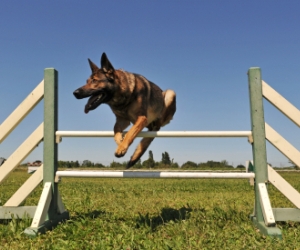4 Dog Training Mistakes You Should Avoid At All Costs

There’s nothing like having a loving furry companion to spend some time with you and your family—unless that furry companion is also very well trained! There are many different ways to go about training your dog including the easiest, sending them to training school. Of course, this costs money and unless you have a difficult personality on your hands, is not really necessary as long as you have the time and patience to put in yourself.

If you decide to go this route, no matter what training philosophy you’re working with, these four dog training mistakes are sure to throw a wrench in your efforts. In fact, repeatedly making these dog training mistakes could eventually mean it’s off to training school for Fido to correct the problematic behavior that has been hardwired into his or her brain—avoid these mistakes at all costs.
A lot of pet owners tend to think that training is a one-time thing where their dog will learn a behavior or trick and then will repeat it for life. Just like with a person who learns to hit a baseball, without regular practice, the behavior will diminish in skill throughout time. This drop-off rate can be avoided two ways. First, be sure your keep the training up, with regular dog agility course sessions which keep your dog on a schedule where they understand it’s time to learn and perform. Then, hold random training sessions or “tests” to keep them on their toes. If a dog expects every training session or command, they will just respond to it at their own whim, not yours. But if the commands are unpredictable as well as scheduled, your dog will learn the actual command, not just your expectations.
Many people who train their dog on their own aren’t quite sure when to stop the session. For some, this results in a training session that is too short, ultimately leading to the dog forgetting the behavior. For others, this results in a session that is too long, causing the dog to become disinterested and ultimately, rebellious to the new behavior. The key here is to optimize the length of your session and there is one simple way to do that: as soon as you gain a positive result and administer the reward, the session is over. Don’t stop before this happens and don’t go on after it happens. Training is a process, not something you can achieve in one day. Likewise, training isn’t over until something is achieved. Simple. Remember that 20 successful 10-second sessions in a day yield better results than 10 successful 20 minutes sessions. Another option you can try is enrolling your dog in a dog training school to make it learn the tricks of the trade.
Another big mistake dog trainers make is only teaching their pet to perform actions in one location. For instance, it might be easy to get Rover to sit in your fenced-in, quiet backyard, but try doing it in the middle of a public park and you’re likely to get very different—and disappointing—results. Unless you hold your training sessions in varying areas, your dog will only respond to behaviors in the area they are learning it in. This isn’t the dog’s fault, this is the trainer’s. Start off with training at home, then increase the distractions each day. Turn on the TV, have a friend in the yard with you, move out into the street, try it with a few people around, move to the park—step up each distraction once you feel that the behavior has been ingrained in the previous environment. This makes the training distraction-proof.
There are a few issues with punishment while training and all depend on what school of training philosophy you adhere to. Regardless, there are two general truths with punishments that can create big problems. The first is that if you are going to administer punishments, you have to catch the dog in the act to administer them. For instance, if the dog wets the carpet, rubbing his or her nose in it won’t help. They’ll just think you’re mean or crazy. Instead, having a can of pennies to shake and scare the dog out of an action while it’s taking place is the only type of punishment that will work. Second, many owners begin a punishment—even a verbal admonishment—with the phrase, “Get over here.” So, the dog comes over to you and you proceed to get angry. Now, if you’re the dog, why would you ever “come” again? Last time they did, you got angry—the dog doesn’t want that so the dog won’t come. In the dog’s mind, you’re punishing the dog for coming. You have to go to the dog, plain and simple.
